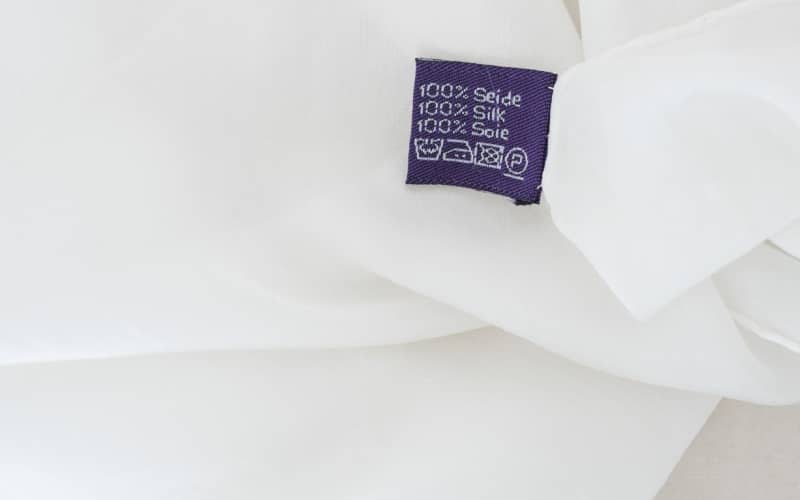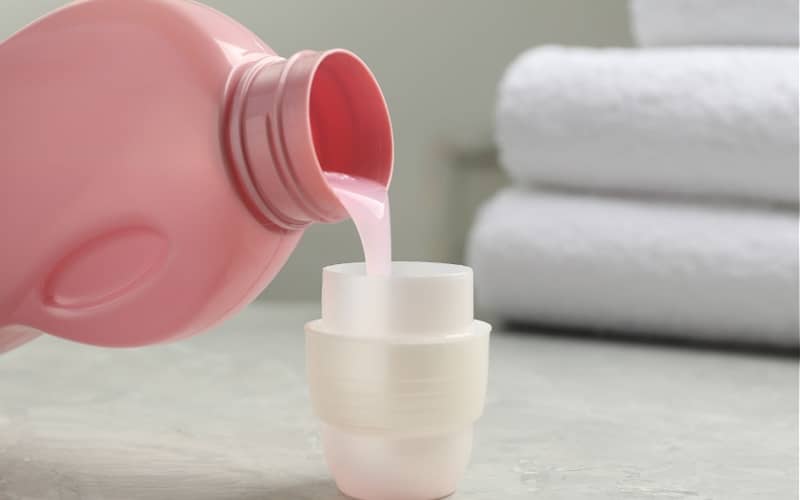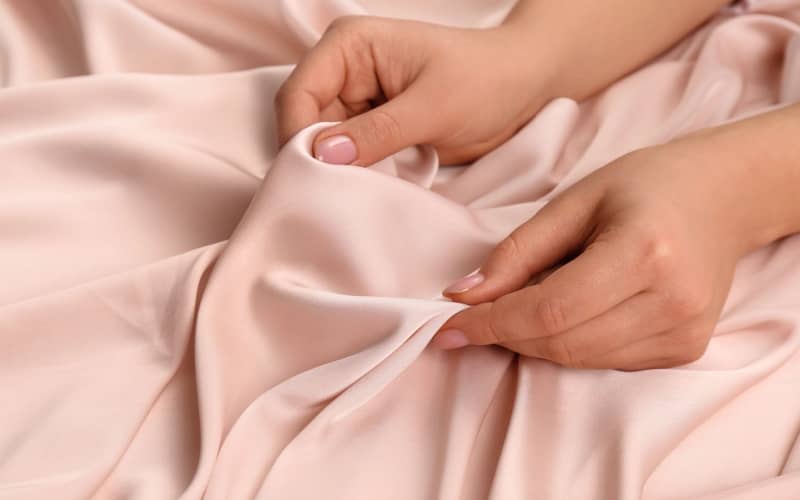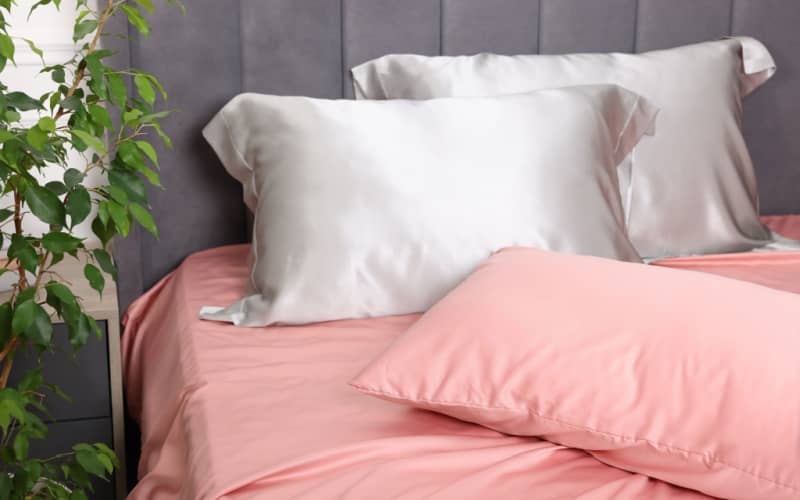When it comes to comfort, silk bed sheets are hard to beat.
Woven from the natural protein fibres of silkworm cocoons, silk has a super smooth texture that effortlessly glides against the skin.
Silk sheets are also breathable, moisture-wicking, and even resistant to dust mites.
But because silk sheets feel so delicate, some might wonder if they can even be washed at home.
Luckily, you don’t always have to take them to the dry cleaners.
Most silk sheets can be hand-washed or machine-washed safely — just handle them with care!
Pre-Treating Stains | Washing | Drying | Whitening | Care Tips
Before Washing Silk Sheets
Before washing silk sheets, read the care label first.
Every set of silk sheets is a little different. There are several types of silk, and manufacturers use different dyes and weaves.
The label will tell you exactly how to wash and dry your silk sheets.
Next, look for a gentle detergent labelled safe for silk or wool. Ideally, it should be pH-neutral and free of enzymes.
Avoid highly alkaline detergents (those with a high pH!) as these can damage silk fabrics and dull the shine.
If you’re unsure, dilute the detergent with water and dip a pH test strip in the solution. Refer to the instructions on the packaging to interpret the results.
If the detergent is too alkaline, do not use it on your silk sheets.
Also, skip enzyme-based detergents. Since silk is a protein-based fabric, enzymes can break down the fibres and weaken them over time.
And one more tip: always pre-treat stains before washing your silk bedding!
Pre-Treating Stains on Silk Sheets
When tackling stains on silk sheets, act immediately — fresh stains are easier to remove than older ones.
Always use cold water and gentle stain removers like salt water, silk-safe detergent, and vinegar.
Still, test any stain remover on an inconspicuous spot first to make sure it won’t cause any damage.
And remember: never scrub silk sheets to avoid deforming the fabric.
If the stain is too large or stubborn, it’s best to contact a professional laundry service to safely treat the stain.
Option 1: Salt water
USE FOR: Blood stains
Salt’s natural absorbent properties can help lift blood stains (especially fresh ones!) from silk sheets.
Turn the sheet inside out, then rinse the stain under cold running water to help flush the blood out.
In a bowl, mix 1 tbsp of salt per half cup of hot water. Let the solution cool by adding a few ice cubes.
Once it’s cooled, soak the stained area in the salt water solution for 10–15 minutes.
Next, gently dab at the stain with a soft sponge and rinse the area thoroughly.
If the stain lingers, repeat the steps until it’s gone.
Option 2: Silk-safe detergent
USE FOR: Food and drink, makeup, sweat, and urine stains
The same detergent used for washing silk sheets can also work as a spot treatment for stains.
Start by removing any solid bits — like food crumbs or makeup — from the sheet. Then, rinse the stained area with cold water.
Next, mix equal parts detergent and cold water or follow any dilution instructions on the label. Slightly increase the concentration for tougher stains.
Dip a soft sponge into the soapy water and gently dab the stain to help remove it.
Let the solution sit for 10–15 minutes, then rinse thoroughly.
Option 3: White vinegar
USE FOR: Blood, food and drink, sweat, and urine stains
White vinegar’s natural acidity makes it great for breaking down stains — and it’s gentle enough for silk fabrics!
First, rinse the stained area with cold water.
Then, mix equal parts white vinegar and cold water in a basin. Soak the stained area in the solution for 10–15 minutes.
After soaking, gently blot the stain with a soft sponge.
Once the stain lifts, rinse thoroughly with clean water and wash the sheet as usual.
Washing Silk Sheets
So, how to wash silk sheets without ruining them?
Hand washing silk sheets is the gentlest way to clean silk sheets at home.
But if the care label permits, you can machine wash silk sheets on a delicate cycle.
No matter which method you go with, always use cold water (lower than 30°C) and a silk-safe detergent that’s pH-neutral and enzyme-free.
If you don’t have a specialised silk detergent, you may use baby shampoo but test the pH first.
Do not use harsh chemicals like chlorine bleach and fabric softeners as they can harden or discolour silk fabrics.
How to hand wash silk sheets
You can hand wash silk sheets in a large, clean basin or tub.
Start by filling the basin or tub with cold water. To make rinsing easier, add just 1-2 tbsp of silk-safe detergent. Agitate the water to mix the detergent thoroughly.
Next, submerge the sheets in the soapy water. If they’re overcrowded, you can wash the rest in another basin.
Let the sheets soak for 10–15 minutes — don’t leave them for too long, as this can weaken the silk fibres.
Keep in mind that silk is even more fragile when wet. To clean silk sheets, swish them gently through the water or lightly rub them with your hands.
Do not scrub, stretch, or twist silk sheets!
To rinse, drain the soapy water and refill with fresh, cool water. Repeat as needed until the water runs clear.
Afterwards, slowly lift the sheets and gently press out any excess water.
You can also lay the silk sheets flat on a clean towel, then roll up the towel to absorb the extra moisture.
How to machine wash silk sheets
If the care label says it’s safe, you can wash silk sheets in the washing machine — but only with the right settings.
For best results, wash silk sheets in a front load washer. Do not use top loaders with agitators, as they can snag on the delicate fabric.
Always wash silk bedding separately or in a silk-only load to prevent rougher fabrics from rubbing against it.
For extra protection, wash silk pillowcases inside-out.
Then place each item — including the fitted and flat sheets — individually in a fine mesh laundry bag.
Use a delicate cycle and cool water for washing, and add about 1 tbsp of silk-safe detergent.
How to Dry Silk Sheets
The best way to dry silk sheets is by air drying them away from direct sunlight.
The sun’s UV rays can fade the colour and weaken silk fibres over time.
You can air dry silk sheets indoors or outdoors in a shaded area.
Carefully hang silk sheets on a line or lay them on a smooth, flat surface.
Make sure there’s nothing sharp or rough in the area that could damage the delicate fabric!
Silk naturally dries quickly, so you don’t have to wait too long before the sheets are ready to use again.
How to Whiten Silk Sheets
If your white silk sheets are looking a little dull, try rinsing them with distilled white vinegar.
Vinegar can brighten whites and remove detergent residue.
After hand washing silk sheets, soak them in cool water with ½ cup of vinegar for 2–5 minutes. Then, rinse again with clean water.
If you’re using a washing machine, pour ½ cup of vinegar into the final rinse cycle.
How To Keep Silk Sheets Feeling Luxurious
To preserve the quality of your silk sheets, wash them weekly. This includes your silk sheets and pillowcases!
Just like any other type of bedding, silk sheets easily absorb body oils and dead skin cells.
Excessive dirt build-up can lead to stubborn residue and stains, which could make your silk sheets feel less smooth.
It’s also best to rotate between two or three sets. That way, you can extend the time between each wash and prolong the sheets’ lifespan.
After washing the sheets, fold them properly (especially the fitted sheets!) and loosely to prevent creases.
Store the sheets in a breathable fabric bag and keep them in a cool, dry spot.
Lastly, keep the rest of your bedding clean to avoid dirt from transferring to your silk sheets. This includes:
FAQs About Washing Silk Sheets
Here’s everything else you need to know about cleaning your silk bed sheets!
Can you wash 100% silk in the washing machine?
You can machine wash 100% silk if the care label allows it.
However, some silk sheets require hand washing or even dry cleaning.
If machine washing is permitted, use a front load washer as it’s gentler on fabrics.
Place each item in a fine mesh laundry bag to protect the fabric, then use a gentle wash cycle and cold water.
Should silk sheets be dry cleaned?
Dry cleaning is usually not needed for silk bedding, unless the care label specifically says so.
Look for a plain circle symbol — that means the item is dry clean only.
You can also test if the fabric is colourfast.
Dip a small, hidden part of the sheet into a diluted detergent solution and leave it for 5–10 minutes.
Then, gently blot the area with a cotton pad or soft cloth.
If any dye transfers, the fabric isn’t colourfast and is best taken to the dry cleaners.
Can you put silk sheets in the dryer?
Avoid putting silk sheets in the dryer — too much heat can damage the fabric.
While some care labels might allow dryer use, err on the safe side by running a no-heat cycle quickly (up to 5 minutes).
Then, remove the sheets while they’re still damp and let them air dry completely in a shaded area.
Why are my silk sheets stiff after washing?
Silk sheets becoming stiff after washing is usually a sign of damage to the fibres or residue build-up.
This could be caused by:
- Heat exposure
- Vigorous handling
- Inadequate rinsing
- Using an incompatible detergent
- Mineral deposits from hard water
How do you make silk sheets silky again?
To restore softness and shine to your silk sheets, use white vinegar.
It also helps to use a water softener or distilled water if you live in a hard water area.
Start by hand washing the silk sheets in cool water with a small amount of silk-safe detergent.
During the rinse, soak the sheets briefly in cool water with ½ cup of white vinegar.
This helps to get rid of any residue build-up.
Rinse the silk sheets once more with clean water. Then, finish by air drying in a shaded area to protect the silk fibres.





